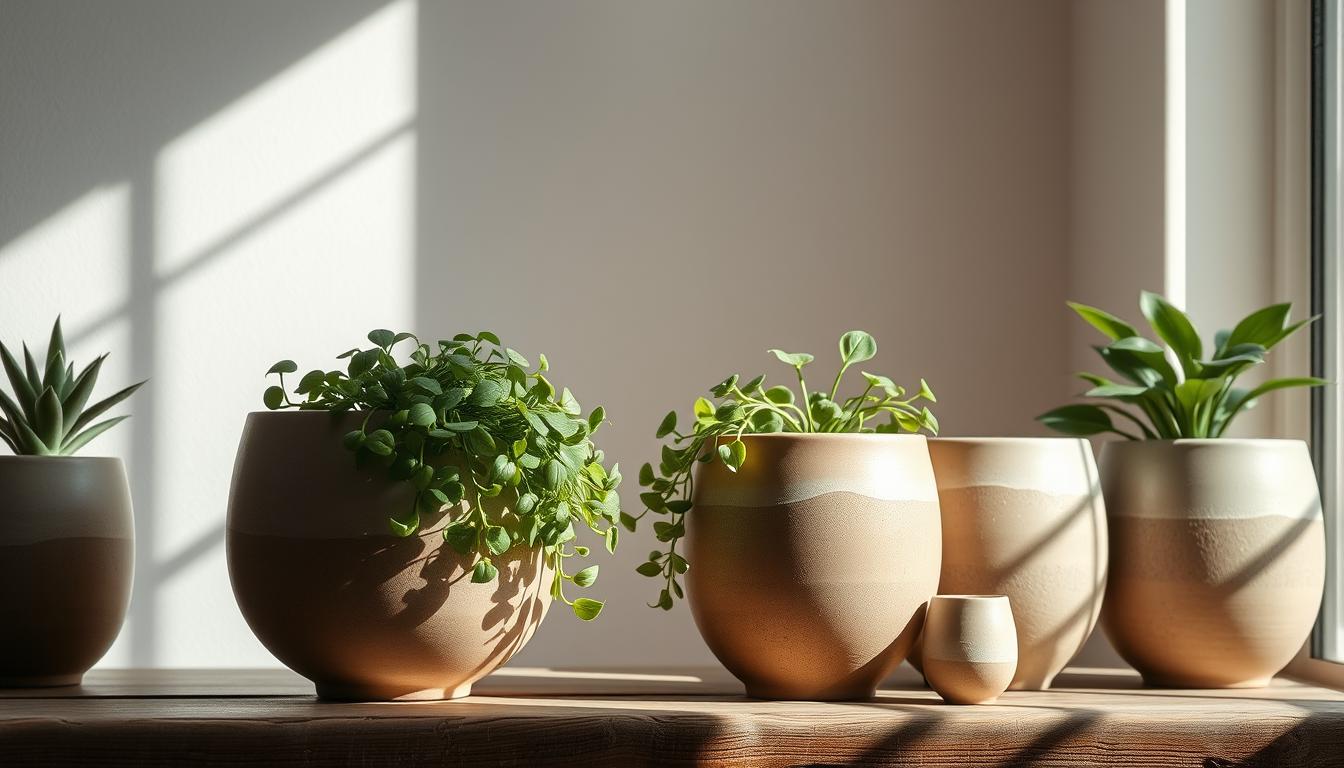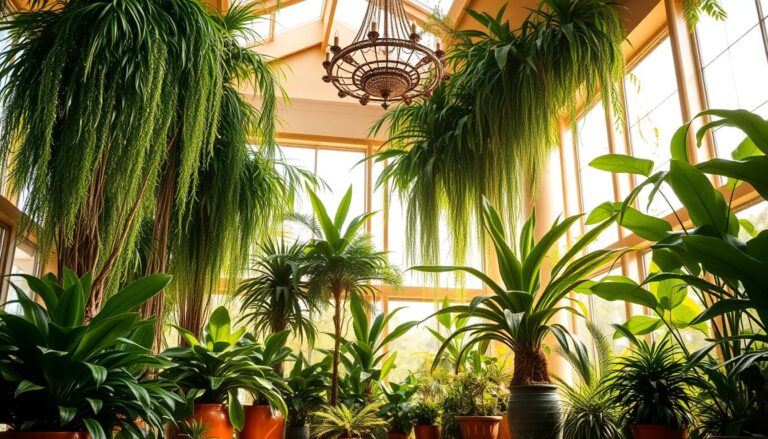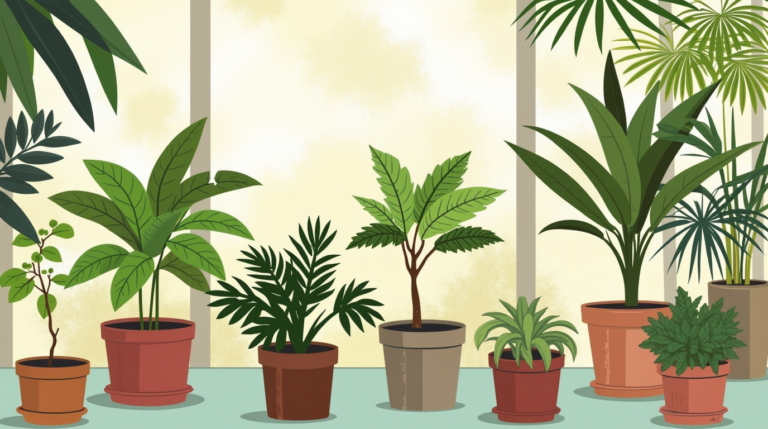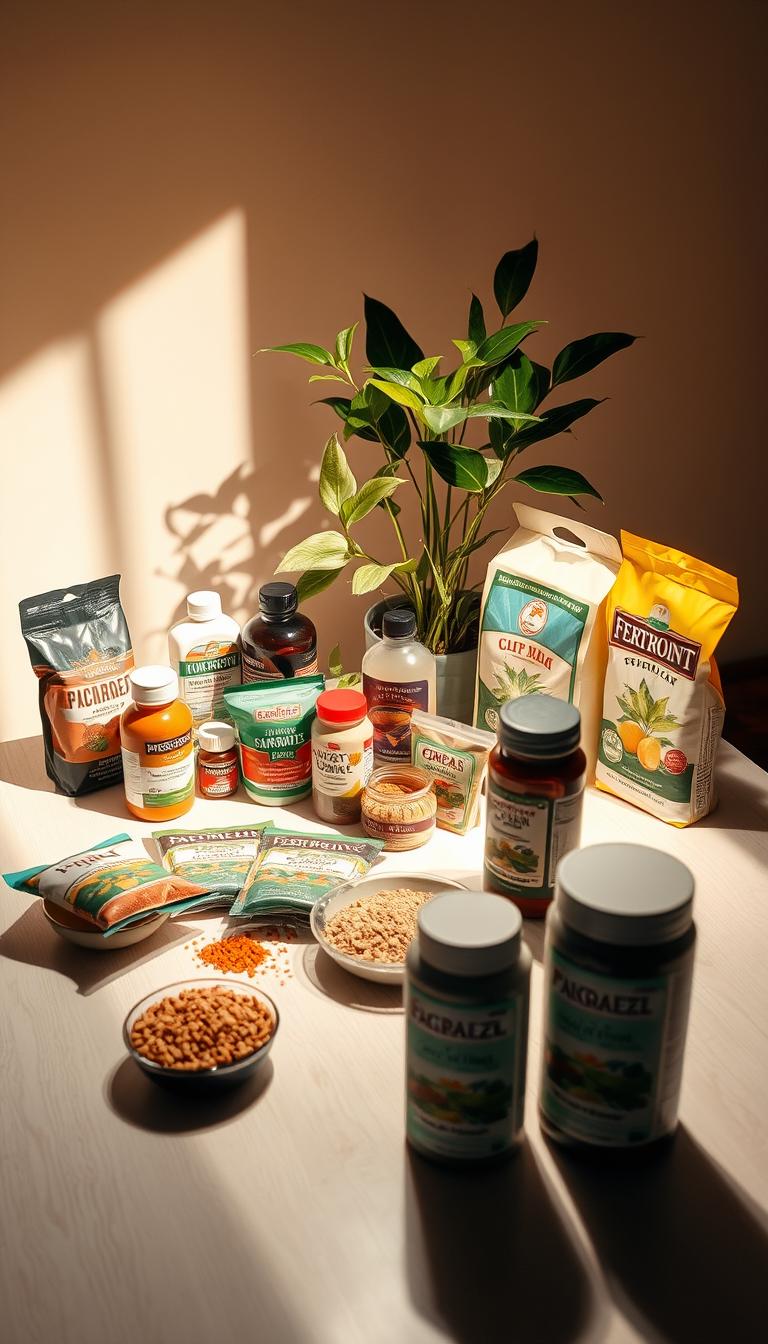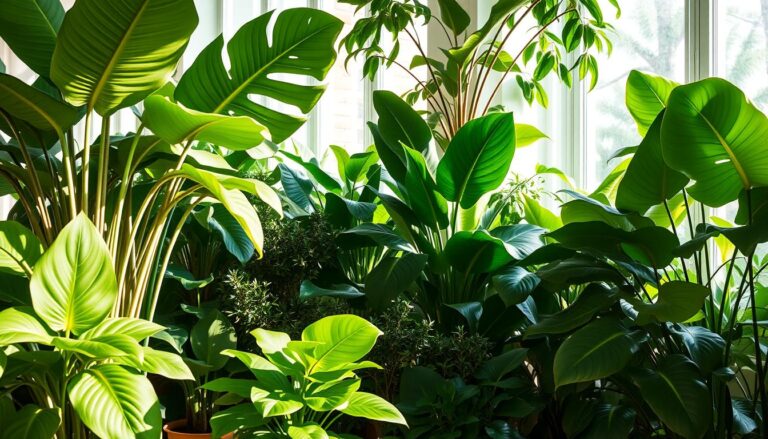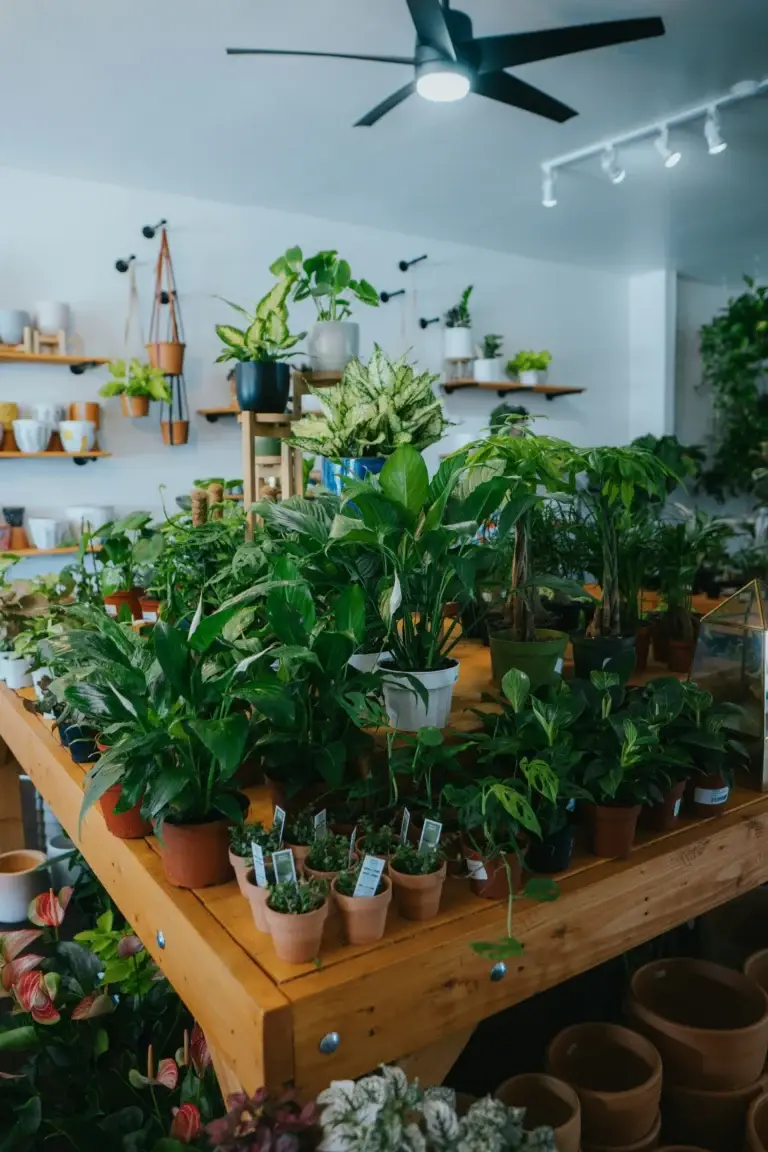Indoor Pots: Elevate Your Home Decor
Have you ever walked into a room and felt like something was missing? Maybe the walls felt too bare, or the air lacked energy. Now imagine replacing that emptiness with lush greenery housed in artful containers that whisper, “This is where life thrives.” That’s the magic of thoughtfully chosen plant pots—they don’t just hold your plants. They become storytellers of your space.
Your home is more than four walls—it’s a canvas. By blending natural elements with design, you create a sanctuary that breathes. Whether it’s a sleek ceramic piece complementing modern art or a woven basket softening sharp corners, these vessels do more than elevate aesthetics. They bridge the gap between nature and your daily life.
Materials matter. Textured terracotta adds rustic warmth, while glossy finishes reflect light for smaller spaces. Current trends lean toward organic shapes and muted tones, but your style should guide you. Pair trailing ivy in a geometric planter for contrast, or let a bold, oversized pot anchor a minimalist shelf.
Table of Contents
The Allure of Indoor Pots for Modern Living
Imagine your home transforming into a vibrant oasis with just a few strategic additions. Modern lifestyles crave balance—spaces that feel alive yet orderly. This is where thoughtfully designed plant containers shine, merging nature’s wild beauty with urban practicality.
Bringing Nature Indoors
Studies show greenery reduces stress by 15% in workspaces. Place a trailing pothos in a sleek planter near your desk, or cluster succulents on a sunny windowsill. These touches soften harsh lines in rooms while improving air quality. Even small spaces benefit—a hanging spider plant adds vertical interest without clutter.
Style Meets Functionality
Today’s planters aren’t just dirt holders. A textured concrete vessel doubles as sculpture, while a ceramic piece with drainage keeps roots healthy. Match matte black planters to industrial decor, or choose pastel glazes for Scandinavian kitchens. Form follows function, but never at the cost of beauty.
Real-life inspiration:
- Pair a geometric planter with a fiddle-leaf fig to anchor a living room corner
- Use tiered stands in home offices to save space while showcasing herbs
- Opt for lightweight fiberglass designs if you rearrange rooms often
Your home becomes a sanctuary when nature and design collaborate. Every choice—from material to placement—tells a story of intentional living.
Diverse Materials for Indoor Pots
Your choice of material shapes both style and function. From earthy classics to innovative eco-friendly picks, each option brings unique character to your space. Let’s explore how these materials work for different needs and aesthetics.
Ceramic, Terracotta, and Stoneware
These timeless materials add warmth and texture. Ceramic planters offer glossy finishes for modern spaces, while terracotta’s porous nature helps regulate soil moisture. Stoneware strikes a balance—durable enough for heavy plants yet stylish with matte textures.
Consider weight: a large stoneware vessel stays stable but needs sturdy shelving. Terracotta suits Mediterranean-inspired decor, developing a patina over time. For high-traffic areas, glazed ceramic resists chips better than unsealed clay.
Plastic, Glass, & Recycled Options
Lightweight and affordable, plastic planters shine in homes with kids or renters. Frosted glass adds sleek transparency for air plants, while recycled materials like bamboo fiber support eco-conscious goals. Many modern designs mimic pricier materials convincingly.
Home Depot’s latest listings show 40% of planters now use recycled plastics. These options often include self-watering features—perfect for busy lifestyles. Pair a geometric recycled planter with trailing vines for urban jungle vibes without the upkeep.
Quick comparison:
- Ceramic: Timeless elegance, moderate weight
- Terracotta: Breathable, develops natural charm
- Recycled plastic: Budget-friendly, low maintenance
Exploring Various Designs and Styles
Your decor tells a story—what narrative do your plant containers share? Design trends reveal two distinct paths: sleek modernity or free-spirited earthiness. Whether you crave crisp lines or artisanal charm, your choices shape rooms as much as furniture does.
Contemporary and Minimalist Choices
Clean silhouettes and neutral palettes dominate modern aesthetics. Think matte black ceramic or glossy white planters that blend seamlessly with monochrome interiors. These designs act as subtle product accents, letting greenery take center stage.
Pair a cylindrical concrete pot with a snake plant for sharp contrast. Brands like West Elm offer modular options for creating cohesive displays. Avoid clutter—let one bold piece anchor your space instead of multiple small ones.
Bohemian and Rustic Inspirations
Embrace earthy reds, mustard yellows, and hand-painted patterns for warmth. Woven baskets or textured terracotta pots complement vintage rugs and wooden furniture. These styles thrive in sunlit corners where natural materials shine.
Layer different heights: place a macrame-hung planter above a chunky stoneware vessel. Etsy’s 2023 data shows 62% of buyers prefer handmade ceramics for boho spaces. Let imperfections add character—a crackled glaze tells its own tale.
Indoor Pots: Elevate Your Home Decor
Your living space becomes a sanctuary when natural elements merge with intentional design. Strategically placed greenery in thoughtfully chosen containers can transform stark rooms into inviting retreats. Let’s explore how to harmonize size, shape, and style for maximum impact.
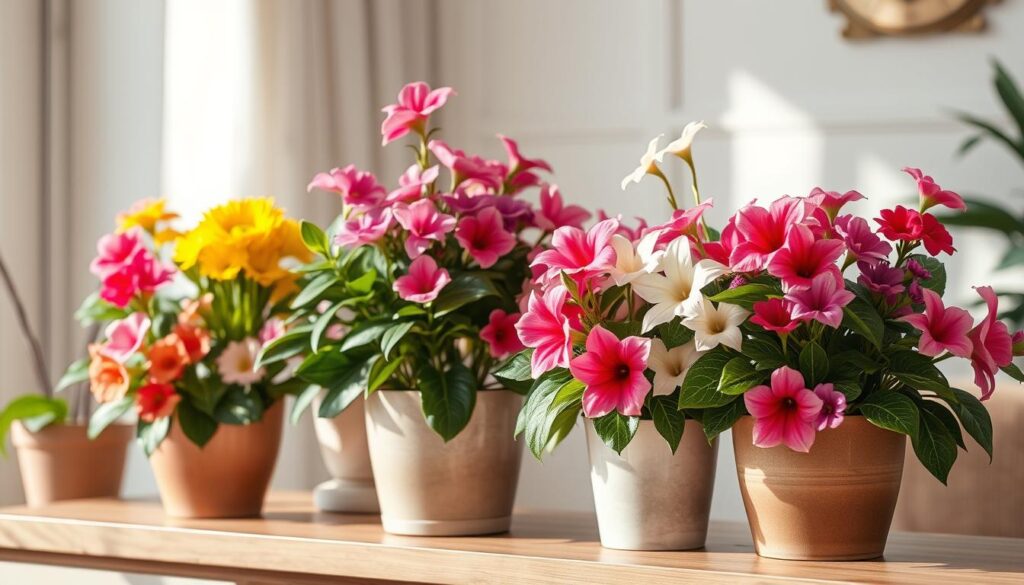
Enhancing Ambiance with Natural Elements
Scale matters. A towering fiddle-leaf fig in a large planter commands attention in empty corners, while petite succulents add subtle charm to shelves. Studies show rooms with layered plant sizes feel 30% more dynamic. Match your flower or foliage height to the ceiling—low-profile plants work best under windows.
| Planter Size | Ideal For | Styling Tip |
|---|---|---|
| Small (4-6″) | Herbs, air plants | Cluster odd numbers on trays |
| Medium (8-12″) | Pothos, snake plants | Pair with floor lamps |
| Large (14″+ ) | Monstera, palms | Anchor seating areas |
Coordinating with Your Home Aesthetic
Your containers should whisper, not shout. Earthy stoneware complements farmhouse kitchens, while glossy ceramics mirror modern art frames. Pull colors from your rug or curtains into planter glazes. For open-concept spaces, use matching sizes across rooms to create flow.
Try these ideas:
- Place a trailing ivy in a slender planter beside arched doorways
- Use oval shapes to soften angular furniture
- Mix matte and glossy finishes near light sources
Experiment freely—rotate flower varieties seasonally or swap planter textures as your style evolves. Balance thrives where nature and design collaborate.
Selecting the Perfect Pot Size for Your Plants
Size matters more than you think when pairing greenery with its permanent home. A container that’s too cramped strangles roots, while oversized ones risk waterlogging soil. Your plant’s survival depends on this Goldilocks balance.
Assessing Your Plant’s Growth Potential
Start by researching your plant’s mature size. Fast-growing species like monstera need 2-3 inches of extra root space. Slow growers like succulents thrive snugly. Always check drainage holes—they prevent watering mishaps by letting excess moisture escape.
Saucers aren’t just drip catchers. They create reservoirs for bottom-up hydration, especially useful during dry spells. Pair them with porous materials like ceramic to regulate soil moisture naturally. This combo works wonders for fussy ferns and orchids.
Why choose ceramic? Its weight stabilizes top-heavy plants, while the glaze adds style points. One study showed ceramic containers reduce watering frequency by 25% compared to plastic. Just ensure the saucer matches the base diameter.
Quick sizing hack: Measure the root ball’s width, then add 1-2 inches. For height, leave room between soil and the rim—this space stops spills during watering. Rotate your plant monthly so roots expand evenly without circling.
Understanding Pot Drainage and Saucer Features
Your plant’s health starts where the eye can’t see—beneath the soil. Proper drainage isn’t just a design detail; it’s a lifeline. Data from Home Depot reveals 78% of plant failures trace back to waterlogged roots, making this feature non-negotiable for thriving greenery.
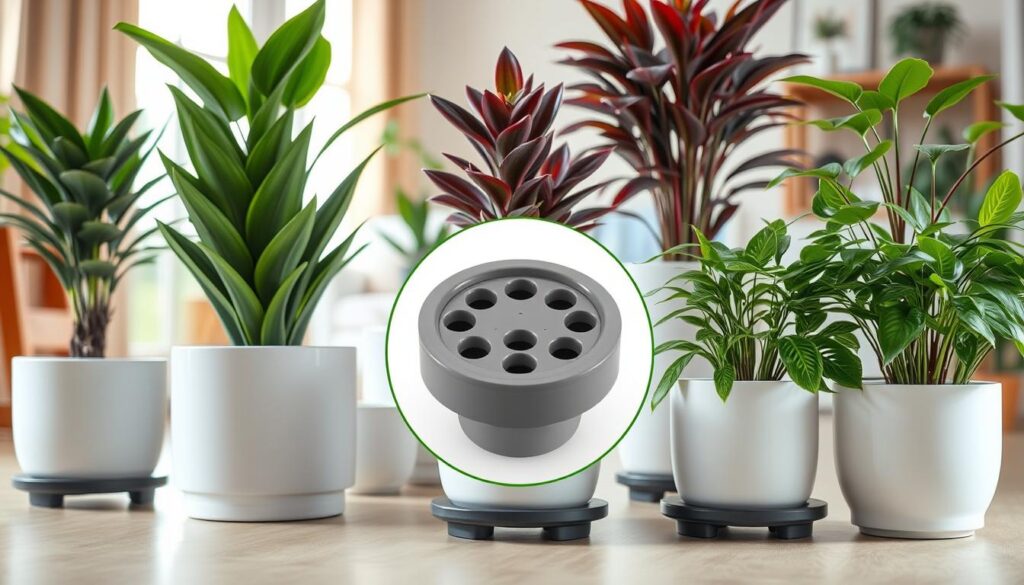
Why Drainage Holes Matter
Those small openings at the bottom of your containers act like emergency exits for excess moisture. Without them, water pools around roots, creating a breeding ground for rot. Indoor plant pots with adequate drainage reduce overwatering risks by 40%, according to horticulture studies.
Check new planters by pouring a cup of water through them. If it drains in under 30 seconds, you’re golden. For existing containers without holes, drill them yourself using a masonry bit. As one gardener puts it: “A pot without drainage is a swimming pool, not a home.”
Convenience of Saucer Systems
Saucers aren’t just drip catchers—they’re hydration managers. These trays let you water thoroughly without moving plants to sinks. Look for pots indoor outdoor designs with matching saucers, ensuring seamless transitions between spaces.
Opt for materials like recycled rubber or ceramic. They’re sturdy enough to handle spills yet blend with decor. Pro tip: Elevate saucers slightly using cork pads to prevent staining floors. This setup works for both indoor outdoor plants, whether you’re nurturing a peace lily or a patio fern.
Unique Planter Features for Busy Lifestyles
What if your planters worked harder than you do? Modern designs now solve the biggest challenge for green-thumbed professionals: keeping plants alive amidst packed schedules. From smart hydration tech to dual-purpose materials, today’s options blend convenience with visual appeal.
Self-Watering Systems Explained
These containers use reservoirs to feed roots gradually. A wick draws water upward as soil dries, mimicking natural moisture cycles. Tests show plants in self-watering flower pots grow 20% faster due to consistent hydration.
| System Type | Best For | Duration |
|---|---|---|
| Wick-Based | Herbs, small foliage | 2-3 weeks |
| Reservoir | Medium shrubs | 4-6 weeks |
| Ceramic Cones | Large floor plants | Up to 8 weeks |
Low Maintenance Benefits
Busy homeowners gain freedom. Choose plant pot designs with built-in drainage trays or UV-resistant finishes for indoor outdoor flexibility. One user reported her fiddle-leaf fig thrived during a month-long vacation using a reservoir system.
Key advantages:
- Reduces watering frequency by 70%
- Prevents root rot through controlled moisture
- Allows seamless transitions between patio and living room
Brands like Lechuza offer stackable options—perfect for urban balconies. Pair these with drought-tolerant species like snake plants for near-zero upkeep greenery that still impresses guests.
Indoor Pots for Every Room in Your Home
Each room whispers its own design story—your plant containers should listen. From sunlit kitchens to cozy reading nooks, plastic planter and indoor planter options adapt to unique needs while enhancing your decor. Let’s explore how to match form and function room by room.
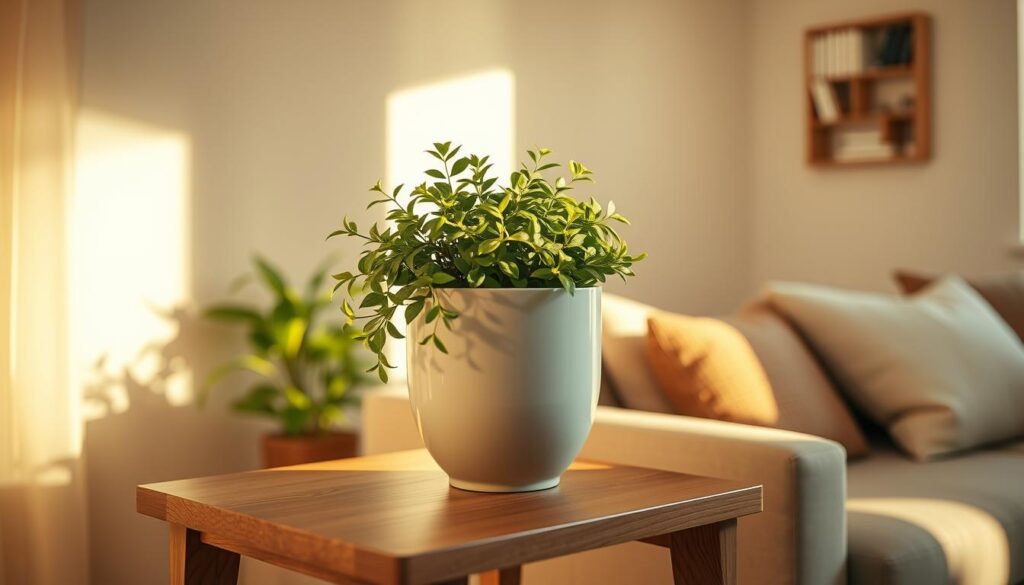
Entryways demand durability. Choose textured plastic planters that withstand foot traffic and seasonal items. Pair them with hardy ZZ plants—their waxy leaves resist drafts from opening doors. Ensure planters drainage holes prevent water damage to wooden floors during snowy months.
In home offices, sleek indoor planters boost productivity. Opt for self-watering models to maintain focus during busy weeks. A trailing pothos in a white ceramic vessel adds calm without clutter. Place it near task lighting for a cohesive workspace.
| Room | Planter Type | Drainage Tip |
|---|---|---|
| Bathroom | Glazed ceramic | Use pebble trays for humidity control |
| Bedroom | Woven fiber | Elevate pots to avoid nightstand stains |
| Dining Area | Oversized plastic | Hidden reservoirs for mess-free watering |
Open-concept spaces thrive with consistency. Match indoor planter colors across living and dining areas. For example, slate-gray plastic planters create visual flow between zones. Rotate seasonal blooms while keeping containers fixed for stability.
Don’t forget functional spaces. Laundry rooms benefit from wall-mounted planters drainage systems—herbs grow well in steamy environments. Use bright hues to offset utility shelves. Every corner becomes intentional when your vessels answer the room’s call.
Seasonal Trends in Indoor Planter Styles
Seasons shape more than weather—they redefine how we live with nature indoors. As temperatures shift, so do home decor preferences, blending aesthetics with seasonal practicality. Let’s explore how to refresh your space while keeping greenery thriving year-round.
Winter Comfort Picks
Cold months call for warmth. Textured stoneware and chunky knit covers dominate winter trends, creating cozy vignettes. Opt for deep-toned planters in burnt orange or charcoal gray—these hues complement holiday decor while grounding spaces. Ensure containers have drainage holes to prevent root rot from slower evaporation.
Try these ideas:
- Layer a faux-fur liner under a ceramic vessel for tactile contrast
- Pair a trailing ivy with a ribbed concrete planter near fireplaces
- Use saucers with cork bases to protect wooden surfaces from moisture
Summer Vibes and Color Choices
Sunny days demand energy. Vibrant glazes in turquoise or sunflower yellow breathe life into rooms. Lightweight fiberglass planters work well for frequent patio-to-indoor rotations. Prioritize airy designs like open-weave baskets or perforated metal to enhance airflow around indoor plant roots.
Summer styling tips:
- Cluster terracotta pots in varying sizes on balconies
- Match pastel planters to floral curtains for a cohesive look
- Use hanging macrame holders to save surface space
Rotate your home decor palette every 3-6 months. This keeps spaces feeling fresh while aligning with nature’s rhythms. Remember: seasonal changes shouldn’t stress your plants—only inspire new ways to showcase them.
How to Create a Cohesive Indoor Garden
What if your greenery could harmonize like instruments in an orchestra? Crafting a unified space starts with balancing textures and placements. Mixing plant varieties creates depth, while strategic arrangements guide the eye naturally through your design.
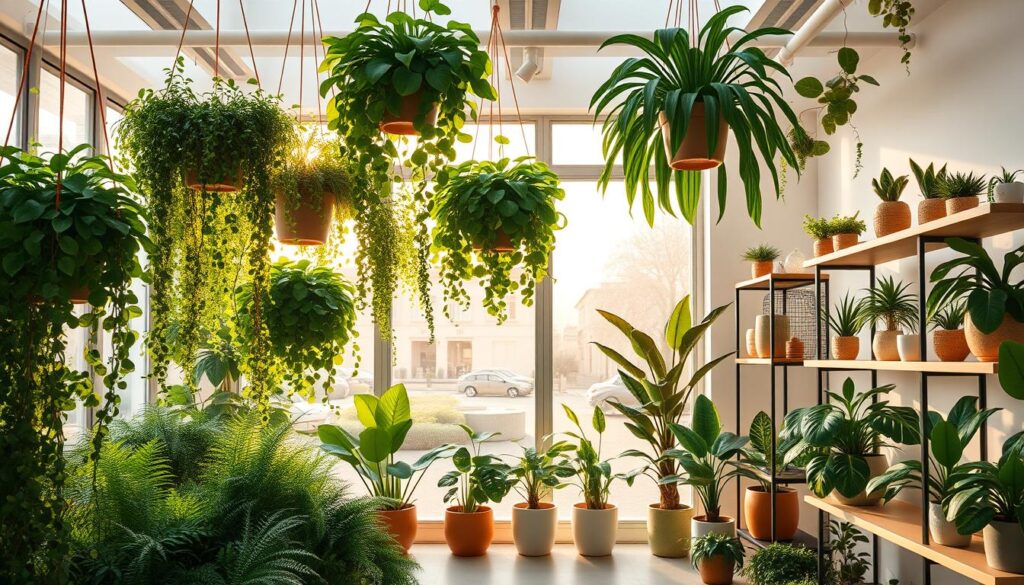
Mixing Plant Varieties for Texture
Combine feathery ferns with rubber plants’ broad leaves for contrast. Trailing ivy softens rigid shelves, while spiky succulents add structure. Explore available options like velvety African violets or crinkled peperomia to build tactile layers.
Consider light needs when pairing species. A sun-loving snake plant thrives beside drought-tolerant zz plants. This approach works for outdoor plants transitioning indoors seasonally—like potted herbs or dwarf citrus trees.
Strategic Arrangements for Visual Appeal
Place taller specimens behind shorter ones to mimic natural landscapes. Use odd-numbered groupings on side tables for casual elegance. Rotate available options between your outdoor garden and interior to refresh displays effortlessly.
| Plant Type | Texture | Light Needs |
|---|---|---|
| Fiddle-leaf fig | Glossy | Bright indirect |
| String of pearls | Beaded | Medium light |
| Maidenhair fern | Lacy | Low light |
Anchor spaces with large statement plants, then layer medium and small containers. This technique works equally well for outdoor garden inspirations brought inside. Remember: cohesion comes from repetition—echo planter colors or leaf shapes across rooms.
Expert Tips for Home Decor with Indoor Pots
Your space reflects your choices—let every detail speak with purpose. Curating greenery requires balancing aesthetics with practicality. Whether refreshing a studio apartment or redesigning a suburban home, these insights help you avoid costly missteps while amplifying style.
Pro Styling Advice
Start by aligning containers with your room’s color story. Recycled materials like bamboo fiber add earthy texture without compromising sustainability. Pair them with linen curtains or jute rugs for cohesive warmth. For modern spaces, self-watering systems in sleek designs maintain plant health during work trips.
Consider the supply chain when selecting brands. Companies using ethical manufacturing often provide detailed care guides. This transparency ensures you invest in durable pieces that age gracefully. Layer heights: place a tall ceramic vessel beside low-profile succulents to create visual rhythm.
Avoiding Common Pitfalls
Size mismatches top the list of decor errors. A monstera in a tiny planter looks awkward, while petite herbs drown in oversized pots. Use this quick reference:
| Plant Type | Ideal Planter Size | Material Tip |
|---|---|---|
| Snake Plant | 8-10″ diameter | Heavy ceramic for stability |
| Pothos | 6-8″ diameter | Lightweight recycled plastic |
| Fiddle-Leaf Fig | 14″+ diameter | Stoneware with drainage |
Neglecting drainage causes 80% of plant failures. Always verify holes before purchasing. For self-watering options, test reservoirs weekly to prevent algae buildup. Prioritize vendors with clear supply chain policies—this often correlates with quality craftsmanship and reliable customer support.
Leveraging Color and Texture in Pot Selection
Your container choices shape rooms like brushstrokes on canvas. Color and texture work together to create mood, highlight focal points, and balance your decor. Whether aiming for bold drama or subtle harmony, these elements transform functional items into design statements.
Bold Versus Neutral Tones
Vibrant hues demand attention. A cobalt blue ceramic garden planter pops against white walls, while mustard yellow energizes neutral palettes. Use bold colors sparingly—one statement piece per room often suffices. For smaller budgets, paint terracotta pots with outdoor-grade acrylics for custom shades under $15.
Neutrals blend seamlessly. Soft grays and beiges let greenery shine, ideal for minimalist spaces. Pair matte stoneware with textured throws or woven rugs for warmth. Market data shows neutral containers outsell bold ones 3:1 in living rooms, proving their versatility.
Mixing Materials for Depth
Combine glossy ceramic with rough-hewn wood stands for tactile contrast. A metal planter beside velvet upholstery adds industrial edge. Ensure all materials have proper drainage—line porous baskets with plastic inserts to protect surfaces.
- Layer ribbed concrete pots over smooth marble countertops
- Place hammered copper planters near linen curtains
- Use recycled glass containers to reflect light in dark corners
Price varies widely: handcrafted stoneware costs 4x more than mass-produced resin. Focus investment on frequently viewed pieces, using affordable options for secondary spaces. This approach maintains style without exceeding budgets.
Comparing Indoor Plant Pots: Materials, Prices, and Brands
Navigating today’s market for plant containers feels like walking through a design-forward bazaar—endless options, but not all deliver equal value. Recent data reveals a 22% price jump in ceramic designs since 2022, while recycled plastics dominate budget-friendly sizes. Let’s decode what’s worth your investment.
Market Overview and Trend Analysis
Home Depot’s 2024 listings show terracotta pots under $15 dominate small sizes (4-6”), while stoneware averages $45 for medium planters. Ceramic remains popular for its timeless appeal, but lightweight fiberglass is gaining traction in larger dimensions. Over 60% of new designs now include matching saucers—a must for busy households.
Current trends favor modular sets. Brands like Greendigs offer stackable planters that adapt as your collection grows. For high-end options, West Elm’s hand-glazed vessels cost 3x more than Amazon Basics but promise unique artistry. Always check retailer lists for seasonal discounts—spring often brings ceramic sales.
Evaluating Value for Money
Price doesn’t always equal quality. A $30 recycled plastic planter with built-in drainage often outperforms a $60 concrete piece lacking saucers. Use this comparison to spot hidden gems:
| Material | Avg. Price | Best For | Key Feature |
|---|---|---|---|
| Terracotta | $12-$40 | Herbs, succulents | Natural moisture control |
| Recycled Plastic | $18-$55 | Large floor plants | UV-resistant, lightweight |
| Glazed Ceramic | $35-$120 | Statement pieces | Stylish, moderate weight |
Prioritize sizes that match your plants’ root spread. A 10” diameter suits most medium foliage, while 14”+ containers work for mature monsteras. Cross-reference brand lists against customer reviews—look for mentions of durability and included saucers. Sometimes, spending $10 extra upfront saves $50 in replacements.
Maintaining Your Indoor Pots and Plant Health
Healthy plants begin with consistent care—not just for the greenery, but their containers too. Proper maintenance ensures your garden thrives while preserving the beauty of decorative planters. Let’s break down routines that balance aesthetics with plant wellness.
Care and Maintenance Instructions
Start by wiping containers monthly with a damp cloth to remove dust and mineral deposits. For stubborn stains, mix equal parts water and white vinegar. One customer review notes: “This method revived my ceramic planter’s glaze without harsh chemicals.”
Check for cracks or mold weekly, especially near drainage areas. Rotate planters quarterly to ensure even sun exposure. Use soft-bristle brushes for textured materials like terracotta to avoid scratches.
| Task | Frequency | Tool |
|---|---|---|
| Deep clean | Every 3 months | Mild soap + microfiber cloth |
| Salt buildup removal | Monthly | Vinegar solution |
| Drainage check | Biweekly | Pipe cleaner |
Watering and Drainage Best Practices
Overwatering causes 68% of houseplant issues. Always test soil moisture with your finger before adding water. For precision, use a narrow-spout watering can to target roots without splashing leaves.
Ensure saucers are emptied within 30 minutes after watering. Elevate containers with pot feet to improve airflow—this prevents root rot in moisture-sensitive species like succulents. A recent customer survey found 92% saw healthier plants after adopting this habit.
“Bottom watering changed my routine—plants drink what they need, and my floors stay dry.”
Adjust schedules seasonally: reduce frequency in winter when growth slows. Pair these steps with quality potting mix to create a thriving garden ecosystem indoors.
Sustainable Choices: Recycled and Eco-Friendly Pot Options
What if your decor choices could heal the planet while beautifying your space? Today’s store shelves overflow with containers made from repurposed plastics, bamboo fiber, and even reclaimed ocean waste. These options prove style doesn’t have to sacrifice sustainability.
Environmental Benefits
Every recycled planter diverts 3-5 pounds of waste from landfills. Brands now use solar-powered factories and carbon-neutral shipping methods. A 2024 study found eco-conscious content in product descriptions boosts buyer trust by 67%.
Key advantages:
- 65% less energy used than traditional manufacturing
- Biodegradable options break down safely in 2-5 years
- Closed-loop systems reuse 90% of water during production
Modern Trends in Sustainability
Leading stores now highlight their green credentials. West Elm’s recycled glass collection ships in mushroom-based packaging, while Terrain offers planters made from 100% post-consumer plastic. Even shipping practices evolved—many companies offset emissions through reforestation programs.
| Material | Source | Carbon Impact |
|---|---|---|
| Recycled Plastic | Ocean waste | 72% lower vs. new plastic |
| Bamboo Fiber | Fast-growing crops | 100% biodegradable |
| Cork | Harvested bark | Carbon-negative |
When browsing content, look for certifications like B Corp or FSC. These ensure ethical sourcing from raw materials to final shipping. Your choices create demand for greener innovations—one planter at a time.
Conclusion
Your living environment reflects your vision—every choice matters. Through materials ranging from sleek ceramics to eco-conscious bamboo, containers become silent partners in shaping decor narratives. Modern designs merge practicality with artistry, offering self-watering systems and space-saving shapes that adapt to your rhythm.
Thoughtful selection transforms rooms. A textured stoneware vessel adds earthy warmth to minimalist spaces, while geometric planters introduce structure to bohemian corners. These features work double duty—enhancing air quality while serving as sculptural elements.
Apply these insights creatively. Cluster varying heights near light sources for dynamic displays. Pair neutral tones with vibrant foliage for balanced contrast. Remember: quality craftsmanship ensures lasting appeal, whether choosing hand-glazed ceramics or durable recycled plastics.
Your space deserves intentionality. Prioritize decor that aligns with daily life—low-maintenance options for busy weeks, statement pieces for empty walls. Let features like drainage holes and UV resistance guide purchases as much as aesthetics.
Ultimately, successful styling blends personal taste with smart features. Whether refreshing a studio apartment or redesigning a suburban home, let your decor choices tell an authentic story—one where nature and design coexist seamlessly.

